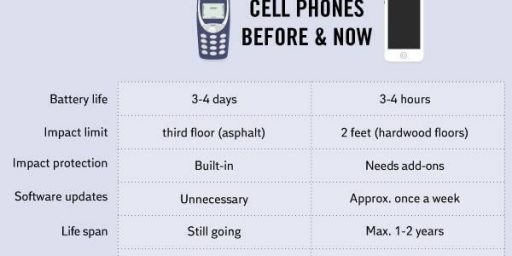One-In-Four U.S. Households Have Ditched The Landline
 A new government survey indicates that the number of American households who have decided to get rid of the once-ubiquitous land-lane phone has hit another high:
A new government survey indicates that the number of American households who have decided to get rid of the once-ubiquitous land-lane phone has hit another high:
One in 4 households has a cell phone but no traditional landlines, a trend led by the young and the poor that is showing no sign of abating.
The 25 percent who had only a mobile phone in the last half of 2009 was up 2 percentage points from the first half of the year, according to data reported Wednesday by the federal Centers for Disease Control and Prevention. Spotlighting how steadily people’s telephone habits are evolving, in the beginning of 2006 just 11 percent of homes had only a cell.
The move away from landlines — just 15 percent of households have a traditional phone and no cell phone, about half the rate of 2006 — is having a widespread effect. It affects everything from how telephone companies stay profitable to how polling firms and government agencies gather data to how 911 service providers locate people in need of help.
Staying steady is the nearly 6 in 10 share of households with both landline and cell service. That figure has essentially remained constant since the beginning of 2007.
As this chart that Mark Perry created shows, this is a trend that has been ongoing, but has increased substantially over the past several years:
This isn’t all that surprising, of course. Cell phone contracts have become both less expensive and more generous over the past several years, while landline and long distance charges have either remained the same or, thanks to taxes, actually increased. Outside of the need to have a means to contact emergency services, there’s barely any reason to have a landline in your house anymore.
Eventually, what I suspect we’ll see is a merging of telephony on all levels to the point where there really won’t be a distinction between cell phones, landlines, and VOIP services. As with most other ubiquitous services, consumers are likely to become more concerned with price and reliability than with how the service is delivered.
Unfortunately, that also means we’ll continue moving toward the day when someone can make contact with you anywhere, at anytime. Unless you turn the damned thing off.







I got rid of the landline for awhile but recently brought it back. Why? Children, too young to be carrying around a cellphone, but old enough to dial 911 in case of an emergency. And landline phones are in a consistent place for them to find.
I haven’t had a land line for about 2 1/2 years now having switched to a cell. My next step is to get rid of my cable TV service, as almost everything I watch on TV these days, other than the local news, I can watch online if I’m willing to wait a day or two after it aired.
Franklin
Yes, I think households with children are probably one area where landlines will still serve a need. Of course, with the growth of VOIP you aren’t really tied into relying on the phone monopoly anymore either
Everything will merge once the government figures out how to get all the landline taxes applied to the other services. One glitch is when their is a change, the tax beneficiary risks losing his monopoly so that slows change as well. Then we’ll have the situation in cellular that we have in land line where the taxes are equal to or greater than the service cost. Look for them to try to roll the taxes into the quoted price like gasoline.
Another reason for a dedicated line is sat. TV. I supposed VOIP would work for this, but the sat. provider requires a dedicated line, or the box costs more per month.